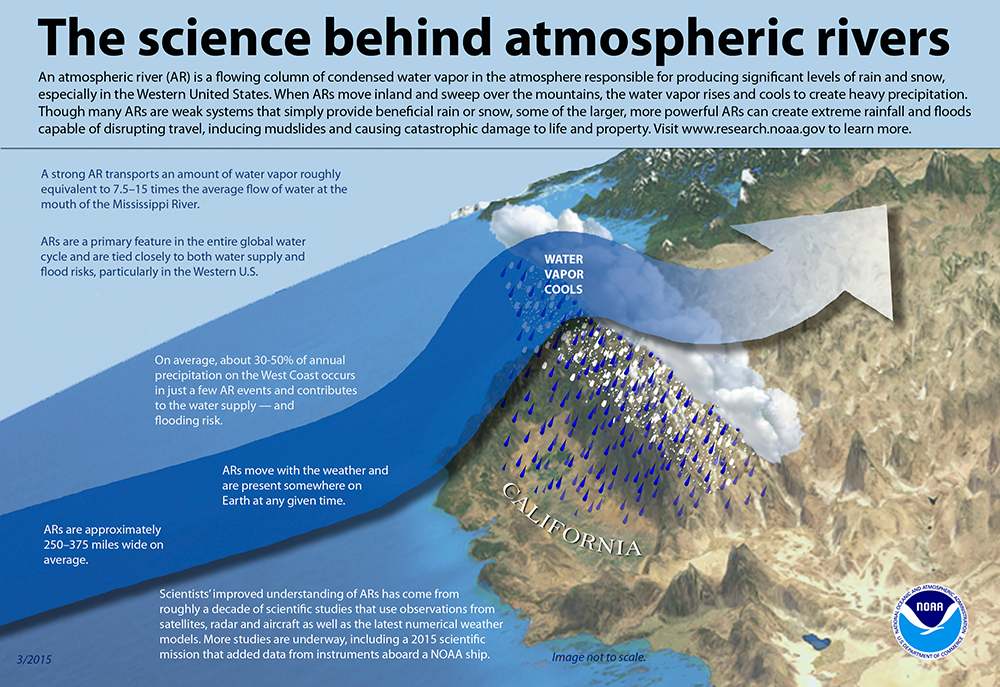
Atmospheric Rivers
It’s an understatement to say November 2021 did not treat British Columbia and parts of Washington well. Catastrophic rain and subsequent flooding ravaged the landscapes, crippled infrastructure, and killed at least five people.
Parts of the Canadian province received 11 inches of rain in two days. Dikes and levees were inundated and overcome. Mudslides occurred rampantly. Tornadoes and waterspouts – rarities in this part of the continent – even spun up. At least 20 rainfall records fell to new champions in British Columbia.
Though we associate mudslides more with California, the entirety of the Pacific Coast is no stranger to these phenomena. The cause of this month’s deluge, however, might seem novel.


The culprit is an atmospheric river.
Sometimes scientists tether fantastical names to weather marvels. One example happens to be the Pineapple Express, which is a storm that arises from warm, moist air near Hawaii, tends to hit California, and is a subset of today’s theme. A wonderful name, but not particularly descriptive when it comes to the nuts and bolts of the event. Other times the descriptors are both figuratively pleasing and literally illuminating, as in the example of our topic, atmospheric rivers.
ARs are, quite actually, rivers in the sky. The National Oceanic and Atmospheric Administration defines atmospheric rivers as “narrow regions in the atmosphere [that] are responsible for most of the horizontal transport of water vapor outside of the tropics.” The movement of moisture in the environment is not uniform, as one might suppose; vapor does not disseminate from the wet tropics equally in all directions. Instead, waterways in the sky funnel moisture toward specific locations.

Atmospheric Rivers normally stretch thousands of kilometers in length but only a few hundred kilometers in width, a geometry that led researchers to liken them to terrestrial rivers in the 1990s. These lofted versions pack more punch even than the mightiest rivers at ground level, however. NASA estimates ARs can carry as much water as 25 Mississippi Rivers!
Anywhere from three to 11 atmospheric rivers exist on the planet at any one point. Interestingly, because of the nature of global weather patterns and currents, ARs tend to intersect with land on the western shores of continents. When they hit, they bring rain and snow. This precipitation is not usually detrimental or even bad. Most of the snowpack of the western United States arrives thanks to ARs. A Pineapple Express might provide the bulk of rainfall for an entire season. When conditions are particularly ripe, flooding and mudslides wreak havoc, but rain is obviously a necessity.
Research indicates that 90% of the global north-south water vapor transport happens thanks to ARs, which usually cover less than 10% of the earth’s circumference, so these events are critical to the global water cycle.


The Center for Western Weather and Water Extremes developed a scale to measure atmospheric rivers in 2019:
Category 1 – Weak – mostly beneficial
Category 2 – Moderate – mostly beneficial, partly hazardous
Category 3 – Strong – Balance of beneficial and hazardous
Category 4 – Extreme – Mostly hazardous, partly beneficial
Category 5 – Exceptional – Primarily hazardous
The final data for the characterization of the November 2021 river is still outstanding, but it will likely register at least a Category 4. Though the study of atmospheric rivers is nascent, relative to other meteorological factors, data point to stronger and stronger rivers as the climate continues to change. This strengthening might mean more water to some places plagued by droughts, but the disasters that accompany this water might outpace the benefits. Coastal communities will need to prepare for the long term affects of these sky rivers.

Further Reading and Exploration
About ARs – NOAA
Atmospheric River Portal – NOAA
What Is An Atmospheric River, and How Does One Affect California’s Rainfall – Bay Nature Magazine
Climate change may lead to bigger atmospheric rivers – NASA
NEW SCALE TO CHARACTERIZE STRENGTH AND IMPACTS OF ATMOSPHERIC RIVER STORMS – UC San Diego













